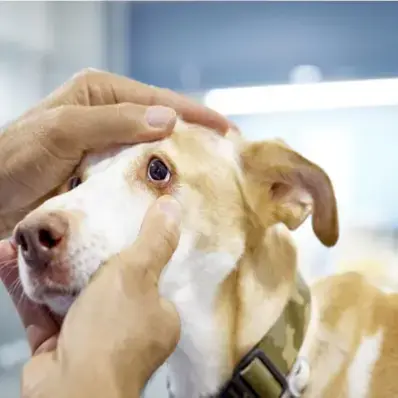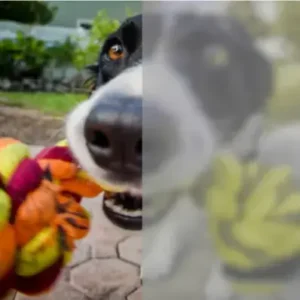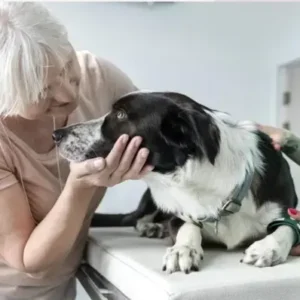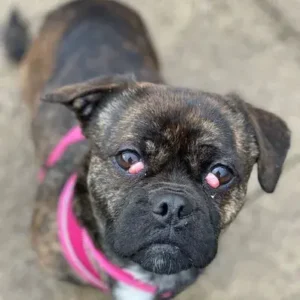Causes and Risk Factors
The primary cause of PRA is genetics. It is an inherited eye disease, meaning dogs are born with the defective gene responsible for retinal degeneration.
Some key risk factors include:
- Genetic inheritance: Progressive Retinal Atrophy is often passed down from the genes of parents to the genes of offspring.
- Breed predisposition: Certain dog breeds have a higher genetic predisposition to PRA, making them more susceptible to the condition.
- Recessive gene: Since most PRA cases are caused by recessive mutations, meaning both parents must carry the gene for a dog to develop the disease.
Responsible breeders screen for PRA genes before breeding to help reduce its prevalence.
Types of Progressive Retinal Atrophy in Dogs
There are two forms of PRA in dogs:
- Early-onset PRA, also known as retinal dysplasia, develops in puppies around 8 to 12 weeks of age, typically around the time they are weaned. In this onset form, the rod cells and cones in the retina fail to develop properly, leading to rapid vision loss.
- Late-onset PRA, on the other hand, affects adult dogs between 3 and 9 years old. This form is characterized by a gradual degeneration of the rods and cones, resulting in progressive vision loss.
Symptoms of Progressive Retinal Atrophy
Progressive Retinal Atrophy (PRA) develops gradually, often making it challenging for pet owners to notice the early signs. Since dogs rely on other senses to navigate their surroundings, subtle vision changes may go undetected until the disease has significantly progressed. Recognizing the early symptoms is essential for timely diagnosis and management.
Here are some of the most common signs of PRA:
Early Symptoms:
- Night blindness, where dogs may struggle to see in dim lighting.
- Dilated pupils, which may appear larger or more reflective than usual.
- Clumsiness, with dogs bumping into objects, especially in the dark room.
Advanced Symptoms:
- Daytime vision loss, making it difficult to navigate even in bright conditions.
- Cloudy or grayish eyes, which may indicate retinal degeneration.
- Increased cautiousness, with hesitation while walking or using stairs.
PRA does not cause pain, but adjusting to blindness can be challenging for dogs.
Breeds Commonly Affected by Progressive Retinal Atrophy
Progressive Retinal Atrophy (PRA) is more prevalent in certain dog breeds due to genetic predisposition.
Some of the most commonly affected dog breeds include:
- Labrador Retriever
- Golden Retriever
- Poodle (Toy, Miniature, and Standard)
- Cocker Spaniel
- Dachshund
- Siberian Husky
- Cavalier King Charles Spaniel
- English Springer Spaniel
- Border Collie
- Irish Setter
- Australian Cattle Dog
- Samoyed
- Norwegian Elkhound
Since PRA is an inherited condition, responsible breeding practices, including genetic testing, can help reduce its occurrence in these breeds.
How is PRA Diagnosed?
Early detection is crucial for managing Progressive Retinal Atrophy (PRA) in dogs. Veterinarians typically use a combination of methods to diagnose the condition:
- Ophthalmic Examination: A veterinarian will examine the retina using a special lens to look for signs of damage or degeneration.
- Electroretinography (ERG): This test measures the function of the retina and can detect abnormalities even before visible symptoms appear, making it an effective tool for early diagnosis.
- Genetic Testing: Identifying PRA carriers through genetic testing is particularly useful in breeding programs, helping to prevent the condition in future generations.
The veterinarian will examine the retina and optic nerve for any changes. They may notice increased reflection in the area of the eye that causes it to “glow” in photos when light hits it. In some dogs, these changes can be subtle, and a referral to a board-certified veterinary ophthalmologist may be necessary. Both eyes will typically be affected equally.
Treatment and Management of PRA
Unfortunately, PRA has no cure, and dogs affected by this condition will eventually lose their vision. Because PRA is an inherited disease, affected dogs—as well as their parents and siblings—should not be bred to help prevent the condition in future generations.
Some veterinarians may suggest antioxidants or the supplement Ocu-Glo when PRA is first diagnosed, although there is limited scientific evidence supporting their effectiveness.
If a dog with PRA develops cataracts, treatment is usually not recommended, as it will not restore vision. However, in some cases, cataracts can lead to complications such as inflammation or glaucoma, which may cause discomfort. If this occurs, special eye drops may be prescribed to help manage pain and reduce inflammation.
How to Support a Dog with PRA
To support your dog suffereing from PRA, you can do the following:
- Use verbal cues and teach commands like “step up” or “slow” to help with navigation.
- Keep furniture in place to prevent confusion and help the dog navigate familiar surroundings.
- Leash train for safety, ensuring the dog does not wander into dangerous areas.
- Engage their other senses by using scented toys and textured surfaces for enrichment.
While some supplements, such as Omega-3 fatty acids and Vitamin A, are believed to support eye health, they do not stop PRA progression. It is always best to consult a veterinarian before giving supplements.
Can Progressive Retinal Atrophy Be Prevented?
Since PRA is genetic, the best prevention is responsible breeding. Here are some key measures:
- Genetic screening, as breeders should DNA test dogs for PRA genes before breeding.
- Avoiding the breeding of affected dogs to reduce the risk of passing PRA to puppies.
- Adopting from reputable breeders who ensure puppies are screened for hereditary conditions.
If you are considering getting a breed prone to PRA, ask breeders for health test results before adoption.
Life with a Dog Affected by PRA
Dogs are highly adaptable, and with the right support, they can live fulfilling lives. Here are some tips:
- Dog-proof your home by using gates, non-slip mats, and barriers for safety.
- Train with sound cues, using bells or clapping to help guide the dog.
- Provide enrichment activities such as treat-dispensing toys and scent-based games.
With patience and training, dogs with PRA can continue to lead happy and active lives.








